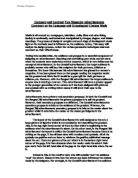Compare the persuasive techniques used in the two charity fundraising advertisements. Which advertisement do you think is more effective and why?
Assignment. Friday, 05th,November,2004
Compare the persuasive techniques used in the two charity fundraising advertisements. Which advertisement do you think is more effective and why?
The hardest thing for any charity is to raise money. There is only one way to do this, that is to persuade people to part with their money and donate it to a good cause. The " Bhopal Medical Appeal" and "Save The Children" advertisements are two examples of this.
Both of these advertisements come from " The Observer" a broadsheet newspaper. Consequently it is assumed that the target audience is those of a higher education and people who more likely to actually read the advertisement.
In both of the advertisements they use very different persuasive techniques. It is easy to see how the two advertisements, both need and want the same thing: the readers' help. However, in many various ways, it is clear that the "Save The Children" advertisement and the "Bhopal Medical Appeal" advertisement have distinct ways of reaching out for the readers attention and support.
First of all " Just 10p a day" is used throughout the 'Save The Children' advertisement. This sticks in the reader's mind and makes them remember the words "Just 10p a day", then makes the reader think what their "10p a day" could do to help save children's lives. The "Bhopal Medical Appeal" advertisement does not use as much repetition as the "Save The Children" advertisement, however it does show the use of some repetition. Such as "That night," words such as these stick in the reader's mind and make them remember what happened "That night", then think about how they can help the people recover from the pain of "That night". This also shows the use of short sentences making the " Bhopal Medical Appeal" advertisement fast paced which increases the tension. From this you can see that the two advertisements use similar techniques; however, the "Save The Children" advertisement uses more repetition.
The two advertisements also use strong adjectives to create an emotive impact on the reader. The "Bhopal Medical Appeal" advertisement uses adjectives such as "Severe" "Filthy" and "New". Adjectives such as these tell the reader more about the situation. It also adds to the emotion of the reader, making them think this is not just "pain"; it is "severe pain". Again, the "Save The Children" advertisement shows a use of adjectives, such as "poorest, hardest," and "generously" make the reader ask themselves if they gave "generously" to the "poorest" and "hardest" working people in this world, maybe they could make a difference with their donation? Therefore adjectives tell the reader more about the situation, help the reader picture an image in their minds, and make the reader question themselves.
Compare the persuasive techniques used in the two charity fundraising advertisements. Which advertisement do you think is more effective and why?
The hardest thing for any charity is to raise money. There is only one way to do this, that is to persuade people to part with their money and donate it to a good cause. The " Bhopal Medical Appeal" and "Save The Children" advertisements are two examples of this.
Both of these advertisements come from " The Observer" a broadsheet newspaper. Consequently it is assumed that the target audience is those of a higher education and people who more likely to actually read the advertisement.
In both of the advertisements they use very different persuasive techniques. It is easy to see how the two advertisements, both need and want the same thing: the readers' help. However, in many various ways, it is clear that the "Save The Children" advertisement and the "Bhopal Medical Appeal" advertisement have distinct ways of reaching out for the readers attention and support.
First of all " Just 10p a day" is used throughout the 'Save The Children' advertisement. This sticks in the reader's mind and makes them remember the words "Just 10p a day", then makes the reader think what their "10p a day" could do to help save children's lives. The "Bhopal Medical Appeal" advertisement does not use as much repetition as the "Save The Children" advertisement, however it does show the use of some repetition. Such as "That night," words such as these stick in the reader's mind and make them remember what happened "That night", then think about how they can help the people recover from the pain of "That night". This also shows the use of short sentences making the " Bhopal Medical Appeal" advertisement fast paced which increases the tension. From this you can see that the two advertisements use similar techniques; however, the "Save The Children" advertisement uses more repetition.
The two advertisements also use strong adjectives to create an emotive impact on the reader. The "Bhopal Medical Appeal" advertisement uses adjectives such as "Severe" "Filthy" and "New". Adjectives such as these tell the reader more about the situation. It also adds to the emotion of the reader, making them think this is not just "pain"; it is "severe pain". Again, the "Save The Children" advertisement shows a use of adjectives, such as "poorest, hardest," and "generously" make the reader ask themselves if they gave "generously" to the "poorest" and "hardest" working people in this world, maybe they could make a difference with their donation? Therefore adjectives tell the reader more about the situation, help the reader picture an image in their minds, and make the reader question themselves.








